Understanding the many different types of wood and their uses can be very helpful for choosing the best wood for your next project. Whether you are building something out of wood or simply choosing wood furniture for your home, this list of the many wood types will help make sure you choose wood you can be happy with!
Wood is available in many different shapes and sizes. Since wood comes from trees and there are many different species of trees it is not surprising we have such a large variety of different woods to use for building.
The Three Main Types of Wood
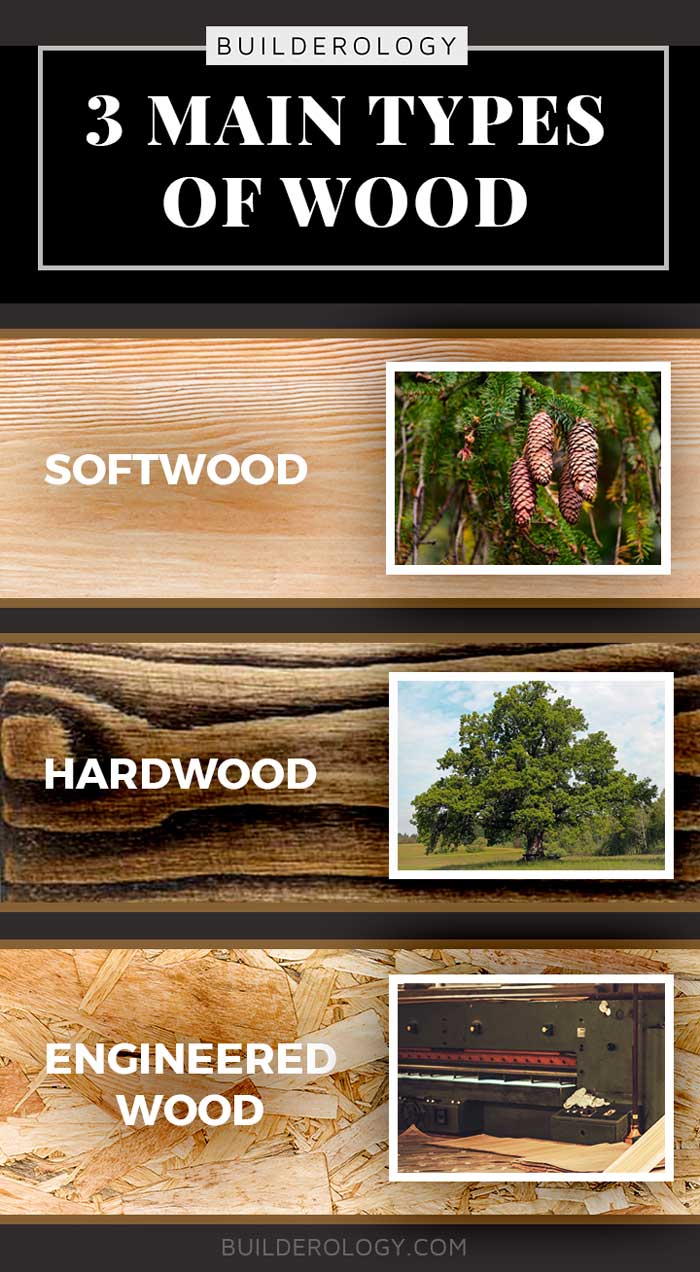
Before we get into all of the different wood varieties and their common uses, it’s important to understand the three basic types of wood you might encounter. These three types are: softwoods, hardwoods, and engineered wood. Each of these different wood types can be used in a number of different ways.
Softwoods
Softwoods are the wood and lumber which are milled from conifer trees. Scientifically known as Gymnosperms, Conifer trees are any trees which have needles and produce cones. Examples of popular softwood trees used in woodworking, construction, and furniture are Pine, Cedar, Fir, Spruce, and Redwood.
Are Softwoods Softer Than Hardwoods?
Contrary to popular belief, softwoods are not named softwoods because they are “soft”. While it is true that some varieties of hardwoods are very hard and therefore more challenging to work with, the distinction between hardwood and softwood has little to do with the actual softness or whether one wood is harder to work with. There are many hardwoods which are softer than softwoods.
How Are Softwoods Like Pine, Cedar, Spruce, Fir and Redwood Used?
Most softwoods are strong and commonly used in many different building applications. Spruce, Pine, and Fir (SPF) are commonly sold under as dimensional SPF lumber at home improvement centers. These woods are often used in framing new construction, as well as building utility style structures.
Many of these woods, particularly softwoods from the cypress family are renowned for their ability to resist rot and insects. This makes trees such as cedar and redwood ideal for exterior projects, such as decking and outdoor furniture.
Hardwoods
Hardwoods come from any trees which do not produce needles or cones. These trees are most commonly are known as deciduous trees, more scientifically known as angiosperms. Hardwoods are trees which produces leaves and seeds.
Common hardwood species include oak, maple, cherry, mahogany, and walnut. Hardwood species are not always necessarily stronger than softwoods, but many species are well known for their beautiful and distinct wood grain patterns.
There are also some woods which are considered to be hardwoods that are not deciduous trees, such as Bamboo and Palm. These plants are scientifically known as monocotyledons, but have many of the same characteristics of hardwoods and so are often classified as such. Bamboo and Palm can sometimes fall under the next classification of engineered wood.
Engineered Wood: Manufactured Wood Products
The third type of wood you may encounter are engineered woods. Engineered wood does not occur naturally in the environment but instead are manufactured.
These boards are generally made with wood which is manipulated to have certain qualities or features. Also known as composite wood, these products are often made from the waste wood of sawmills.
Engineered wood is often treated through chemical or a heat process to produce a wood product which can meet certain sizes that would be difficult to achieve from nature.
Popular examples of engineered woods include Plywood, Oriented Strand Board, Medium Density Fiber Board, and Composite Board. Wood veneers can also sometimes be classified as engineered wood, since it often needs to be manipulated either through specialized cutting techniques or joining pieces together to achieve a specific size or wood grain patterning.
Now that we understand these three main types of wood, we are ready to start exploring all of the different varieties of wood you may encounter and what they are most frequently used for.
Types of Wood for Woodworking, Furniture & Building
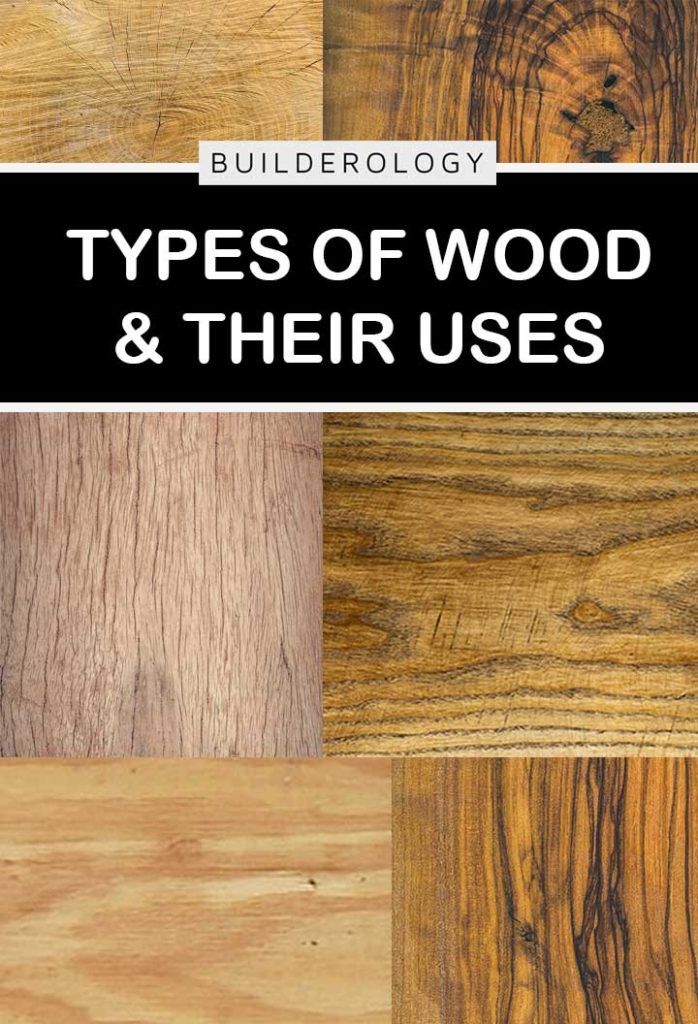
While there are three main types of wood, there are thousands of varieties and species of wood. In this section we’ll cover the most common woods you may encounter in building and woodworking. For each variety of wood, we will give an overview of their common characteristics, and what each type of wood is most suitable to be used for.
All woods are listed in alphabetical order, so if there is a specific type of wood you want to learn about, you will be able to find it easily on this list.
Alder Wood
Alder is a hardwood which is slowly gaining a rising popularity due to its natural beauty, workability and versatility. It is more frequently found in the Northwest regions of California and Southwestern parts of Canada. It is in the same family as the birch tree, so it often shares similar applications.
Alder will appear to be almost white when freshly cut, but quickly turns to warm honey brown once exposed to air and sunlight. This medium density wood usually has a straight grain and is easy to use for carving, turning, and machining.
The wood also works well with a variety of different finishing treatments. Alder wood has a very smooth surface when sanded which can easily be stained or painted.
The Alder tree does not grow to be very large in diameter or height, so this is something to consider if you need very large solid pieces as they may be more difficult and therefore more expensive to obtain.
Alder is used frequently in furniture making and cabinetry. It is also a popular choice for photo frames and other decorative objects.
Perhaps one of the more specialized uses for Alder wood is in the hard body of electric guitars. Alder wood produces a very clean tone that is hard to replicate with other woods. In electric guitars, Alder is often more desirable for its tone than even the exotic hardwoods such as mahogany.
Ash
Ash wood can be somewhat difficult to find currently, especially due to the recent issues with the Emerald Ash borer, an invasive pest which caused many of these trees to prematurely die. If you live in the areas where Ash trees are native and grow abundantly, it will be easier to find this wood than if you live somewhere that does not.
Ash mimics the same strength and characteristics of white oak but typically comes at a more budget friendly price if you are able to find it at a local lumberyard near you. The wood takes stain easily and can be used for many different types of projects.
Aspen
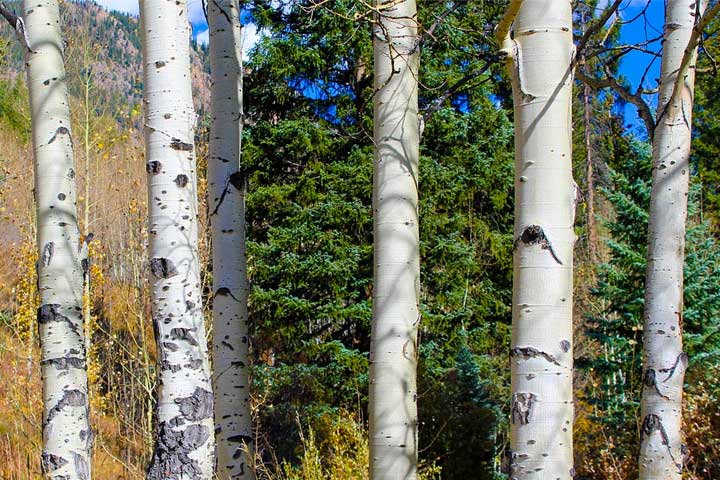
Aspen is a light colored wood which takes painting and stain well. This wood can sometimes appear or feel to have a fuzzy texture.
Aspen is a hardwood grown in Northeast America but can sometimes be difficult to find. Due to its general limited availability, it is typically only used for very specific projects in which Aspen wood is ideal.
One of the most specialized uses for Aspen wood is in the building of saunas. The wood does not conduct heat and can tolerate the moisture well with limited swelling or movement. Because it does not conduct heat easily, it is also sometimes used in the production of matchsticks.
These properties are also what make Aspen desirable for using to build drawer slides in furniture, since this can help reduce sticking. This wood is also odorless and taste free, making it ideal for making chopsticks and kitchen utensils.
Balsa Wood
Balsa is a very lightweight hardwood that is typically used in hobby and craft types of projects. Many fine woodworkers tend to have a negative viewpoint of balsa wood since it is not very strong, but it often under appreciated and has many practical uses.
Most of us first encounter balsa wood in childhood building projects and model kits. Balsa wood may be considered child’s play to most serious woodworkers, but it is also perhaps the very catalyst that introduces many people to woodworking and construction.
This wood also has a very rich history, especially because it was often used as a substitute during World War I and World War II in airplanes and ships.
Balsa wood is typically imported to North America from South America and Central America. Balsa wood grows very quickly but has a relatively short lifespan, with most trees only producing usable lumber before it is 10 years old.
The wood is very buoyant, and many people are surprised to learn that balsa wood is often used in building rafts, life preservers, and other types of items that are designed to float. Surfboards are a great example of beautifully crafted projects that can be made of Balsa wood.
Balsa wood is a low density wood which is generally not very strong. For this reason, many people prefer to choose basswood and birch over balsa wood for any type of project that needs to be able to handle weight or stress.
On the other hand, if you DO need to build something out of wood that can quickly break or come apart, such in the case of building sets for theatre and film stages, balsa is a great choice.
The grain of the wood can easily be painted or stained to use as a veneer in order to achieve a number of looks on the cheap.
When assembling projects that use balsa wood, it is often necessary to use glue, since the wood does not play too nicely with nails or screws. Very thin pieces of balsa wood can often be cut with nothing more than a good utility or craft knife.
Bamboo
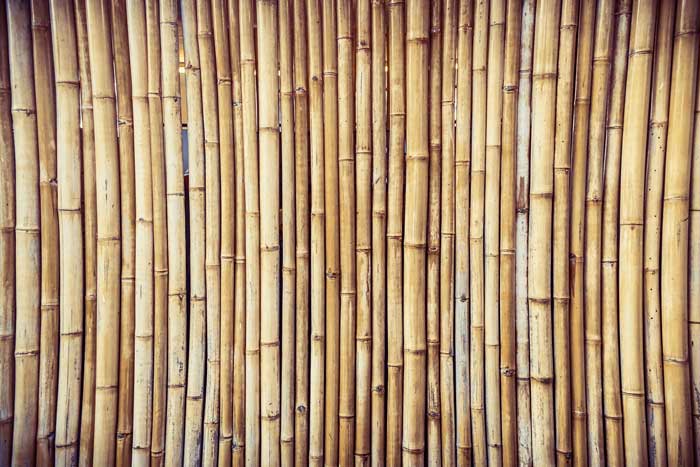
Although Bamboo is technically a grass and not a wood, it can be used for building many things due to the hardness and density of the plant stems. Bamboo grows in abundance in tropical climates and there are a number of different species available, which vary greatly between regions.
The Bamboo plant has a tall, hollow stem. These stems can be used as-is, or they can be cut into very thin, narrow strips to create a veneer. The veneer product from the stems is made into an engineered wood such as plywood.
While people might think that Bamboo would be lightweight, soft, and easy to bend or cut this is not the case. It is better to compare Bamboo to the hardwood Red oak or Maple, since it has a similar hardness and strength. The high density grass can sometimes be tough on tools.
Bamboo stems are especially popular for garden furniture, garden decorations, fences, and privacy screens. You can also see bamboo in cabinets, fine furniture and even as hardwood flooring.
Part of what makes Bamboo able to resist decay outdoors is its natural waxlike coating. If you wish to stain, paint, or glue bamboo, you will need to sand the wood first to ensure the paint or glue grips to the wood. Most bamboo should be sealed and protected for longevity if it is used outdoors.
Moisture can cause Bamboo to swell or shrink, so it is best to let it acclimate to the environment before cutting, especially if you are in a drier and colder climate than where the plant is natively grown.
Basswood
Basswood is a very light cream-colored wood, and has a very straight and tight grain. The wood is not prone to warping or movement once properly acclimated and dried.
Basswood is a hardwood favorite for woodcarvers and woodturners. It is also a very popular choice for those who enjoy miniature woodworking and building models. Woodturners often enjoy working with basswood due to its ease of use and availability.
The wood also has no odor, taste, or known allergens so it makes it a popular choice for food storage crates or even possible use in kitchen utensils. Basswood is easy to find and typically budget friendly.
Basswood can be challenging to stain evenly. In most cases it is best to appreciate simply the natural finish with a protective clear coat of oil or to paint the wood. Many decorative painters enjoy working with basswood projects because once it is primed will allow for a very smooth finish.
Beechwood
Beech is a hardwood that is often used for wood veneers, furniture, and woodturner objects. This cream toned wood has a consistent grain pattern which is usually straight and tight, and occasionally will have gray flecking. The wood is very light in color, but usually has a yellow-reddish cream tone to it.
It is a sturdy wood best known for its ability to easily steam-bend. For this reason, beech is an excellent choice for making any type of interior furniture, such as chairs and other curved pieces. This benefit however can also mean that Beech wood will sometimes suffer from movement, shrinkage and swelling when exposed to high humidity or unpredictable moisture in the environment.
Beech is often found in pianos, used for the bridge and pin blocks of the piano mechanism.
Beechwood is in the more affordable range of hardwoods, and can be found in a wide range of sizes and as a veneer. The wood is relatively easy to work with as long as your tools are sharp. It can be glued and stained without too much difficulty if desired.
Birch Wood
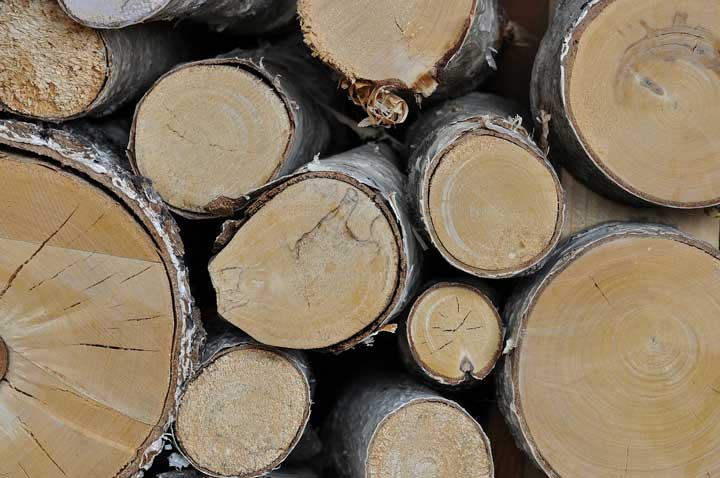
Birch is a hardwood which is easy to find and often one of the more affordable hardwood species at local lumberyards and home centers.
Birch is very strong and can be used for almost everything and anything you can imagine. Many people use birch as a less expensive alternative to Oak.
One thing to know about birch wood however is it can be very difficult to stain. Staining can sometimes result in blotchy patches that look uneven. For this reason, birch is an ideal and economic hardwood to use if you plan to paint your project.
California Redwood
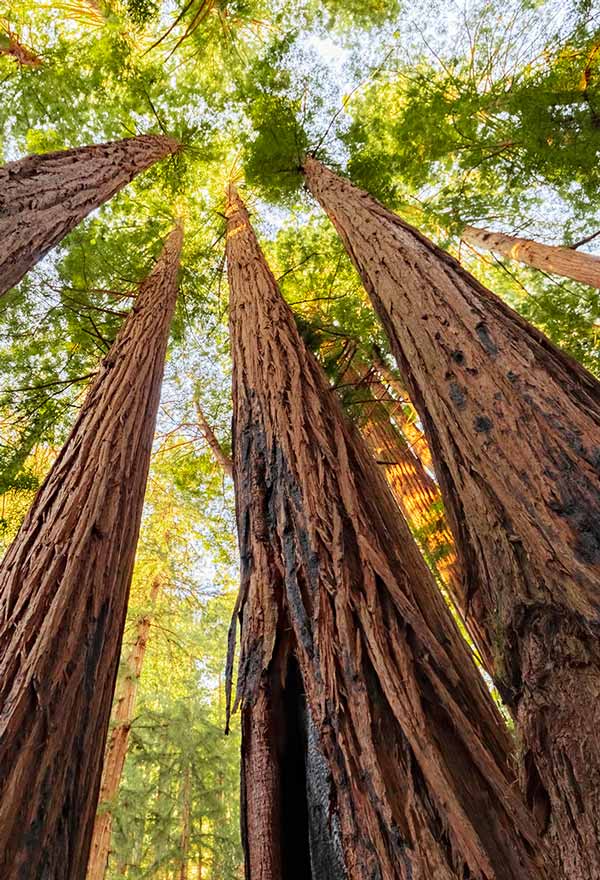
California redwood trees are a popular softwood for outdoor building projects.
California redwood trees are a softwood known best for their massive size and red color. It has a very interesting wood grain pattern, and much likes its Cedar cousins, Redwood is very suitable for outdoor applications due to its ability to be weather resistant.
Redwood is often used for railroad ties and trestles, and it is also popular to use in building retaining walls, decks, and garden borders. Redwood is also a suitable choice for veneers, tables, and large cabinetry projects.
Cedar Wood
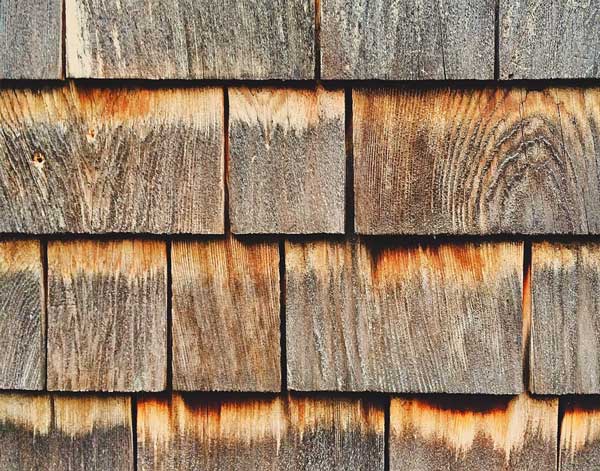
Many people are familiar with cedar not just for its interesting wood grain and color, but also for its aromatic smell which is believed to repel pests and moths. The aromatic scent and bug repelling properties is why it is sometimes a popular choice to use in closets and storage chests.